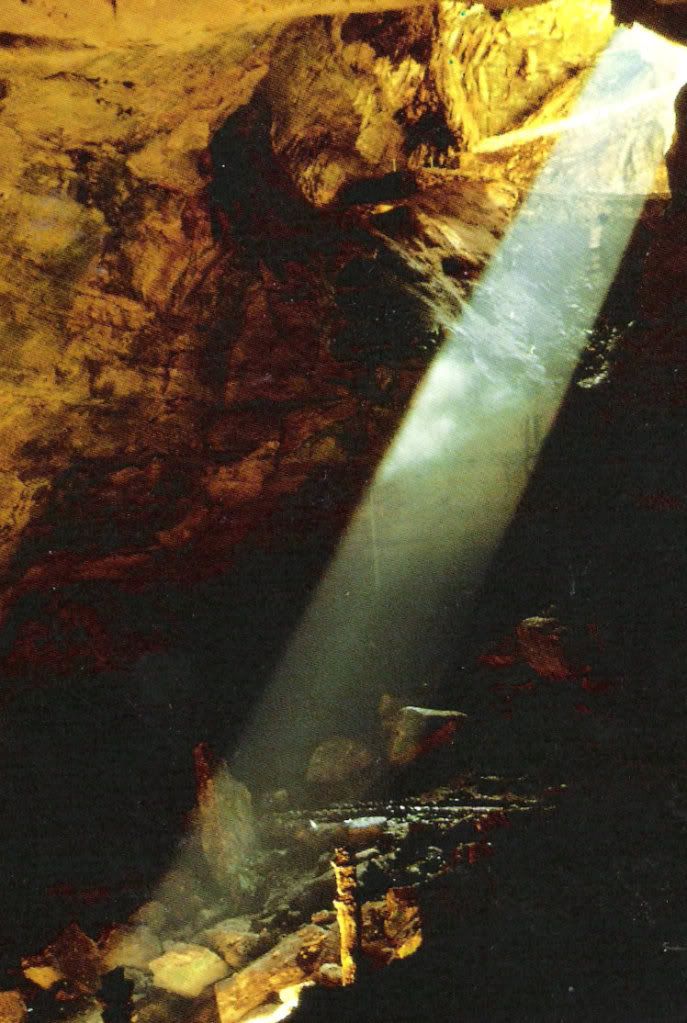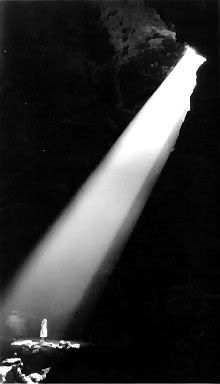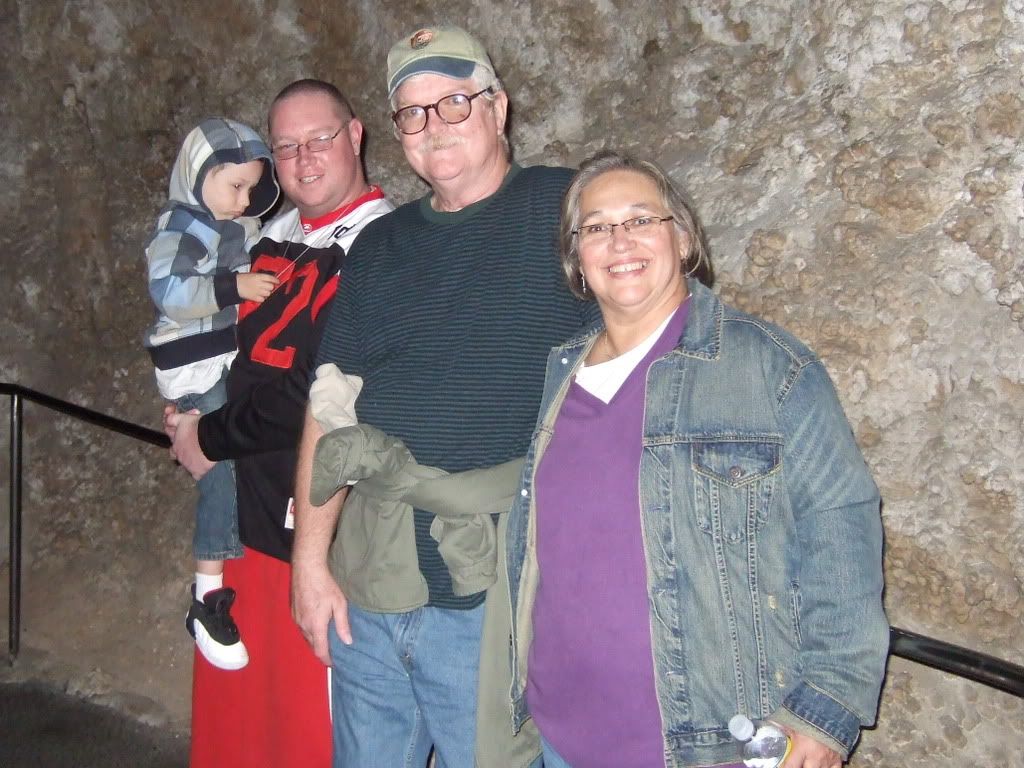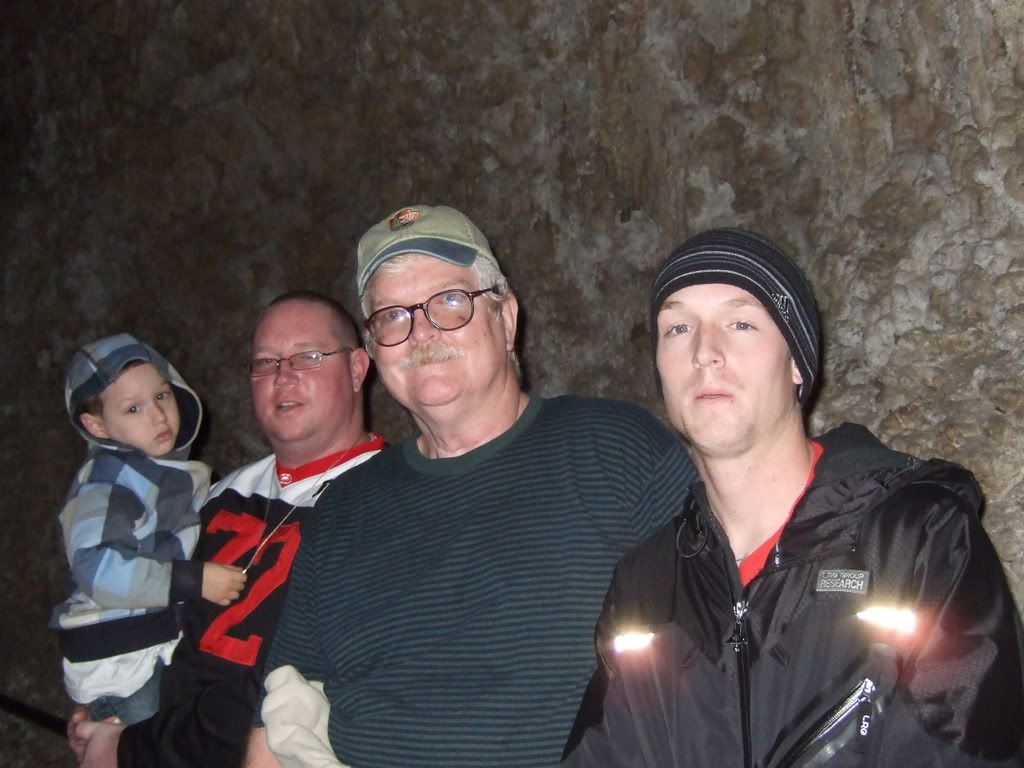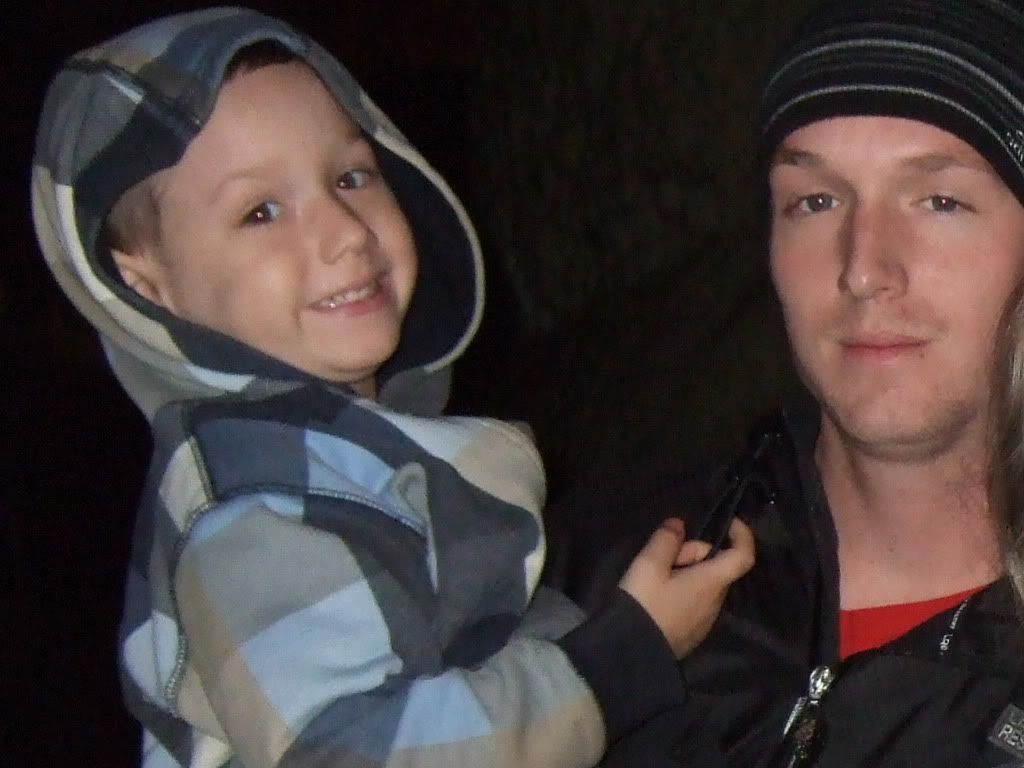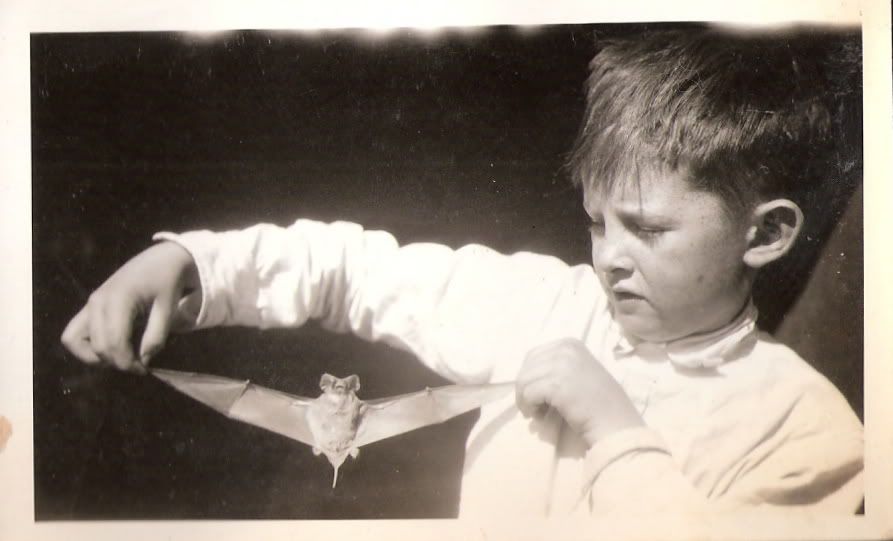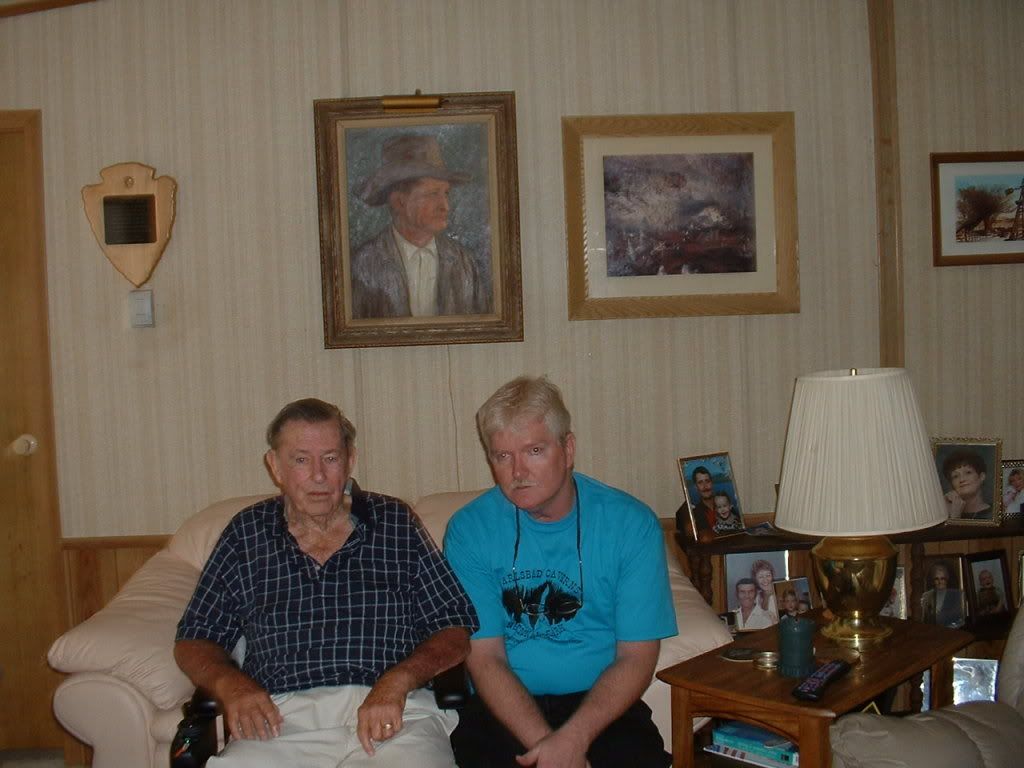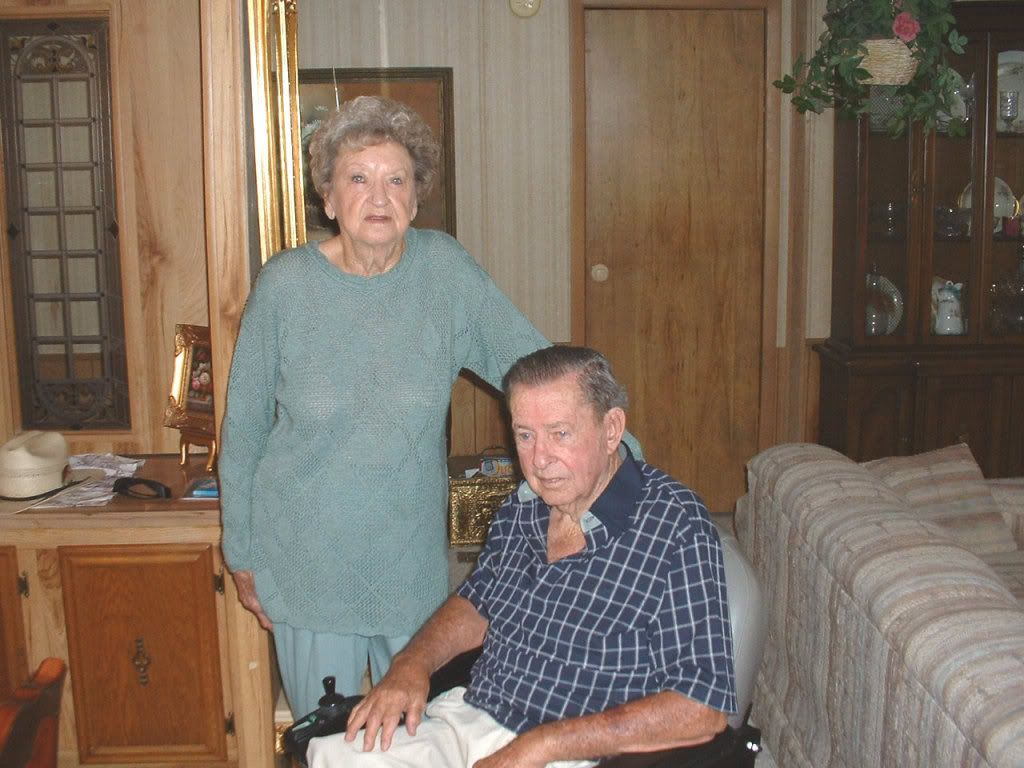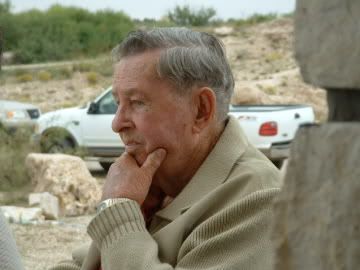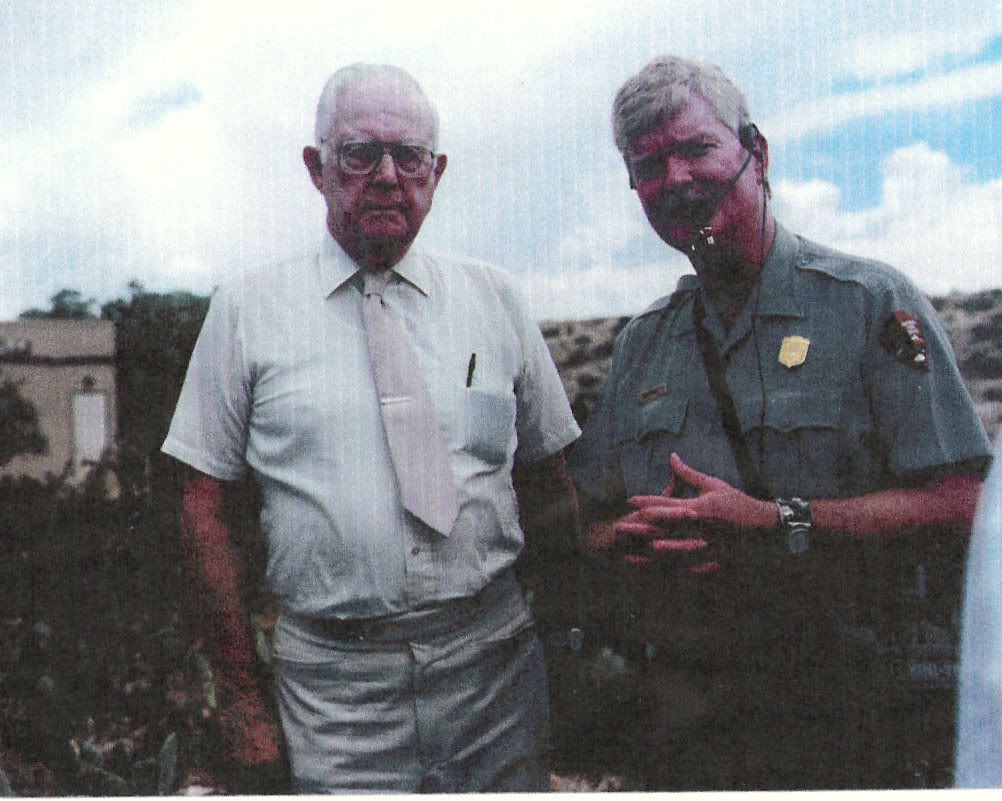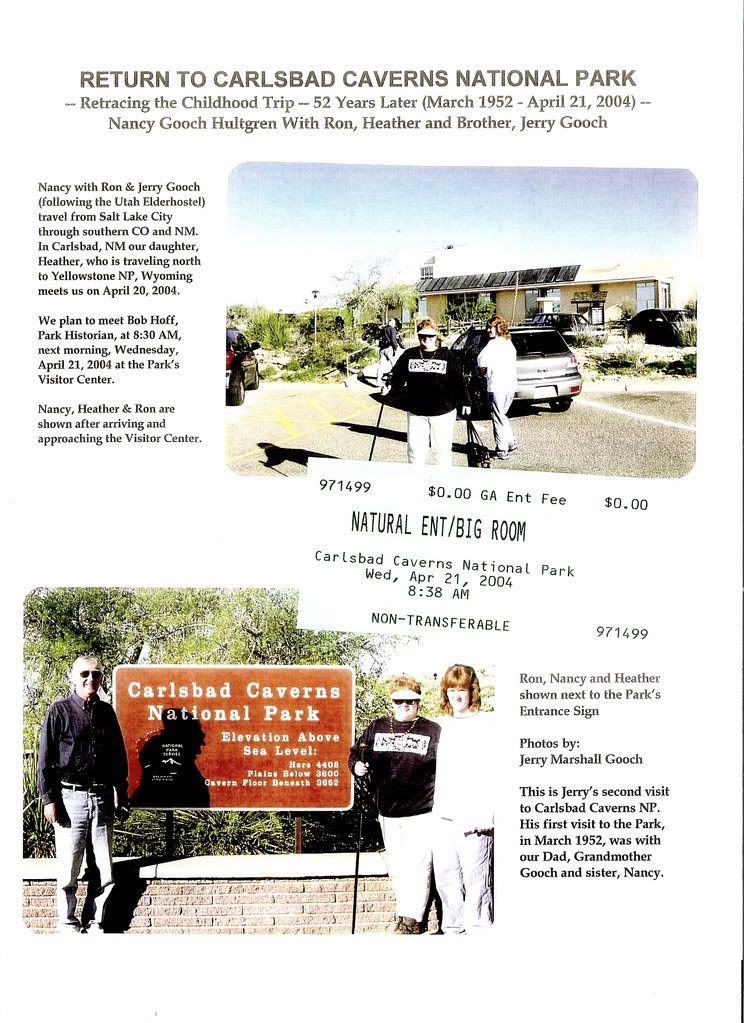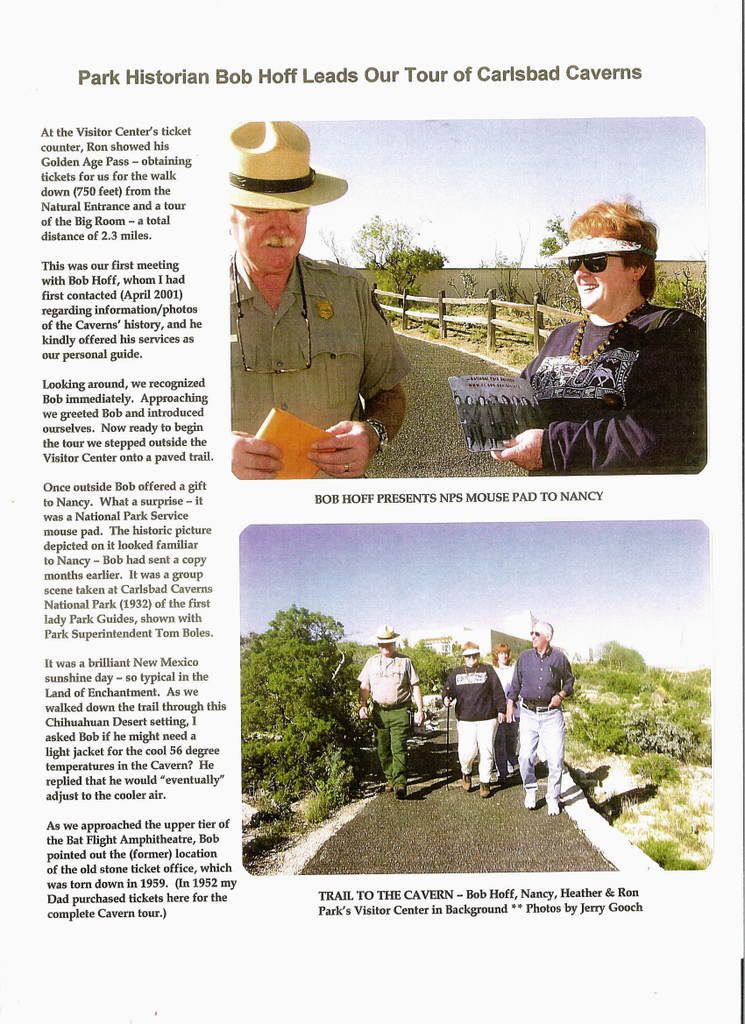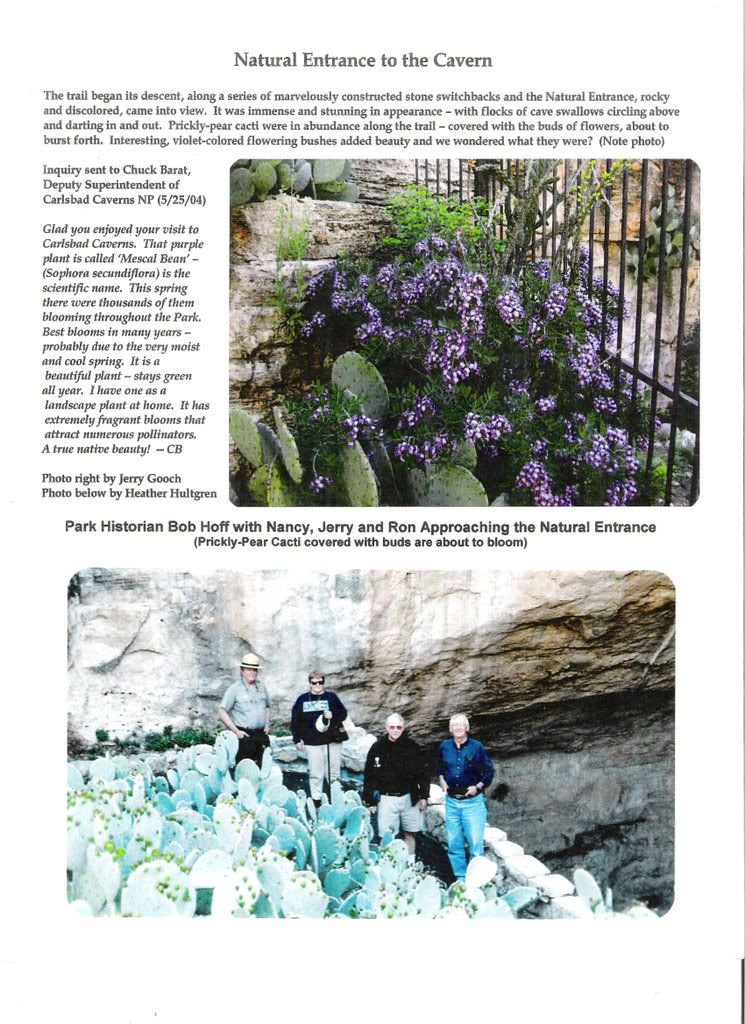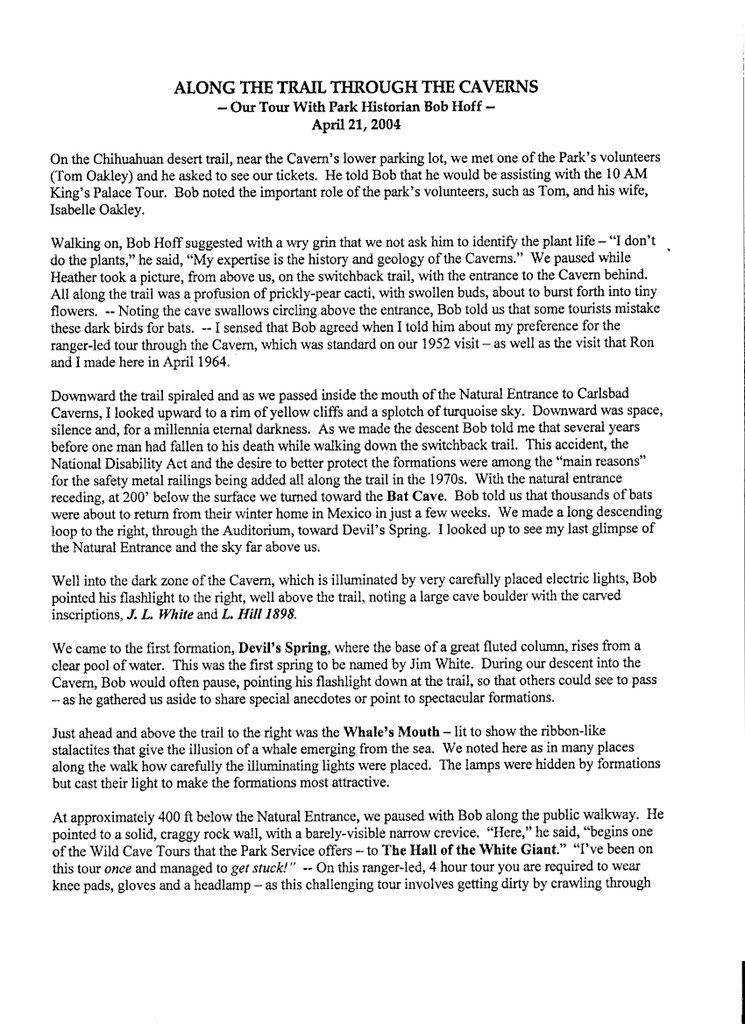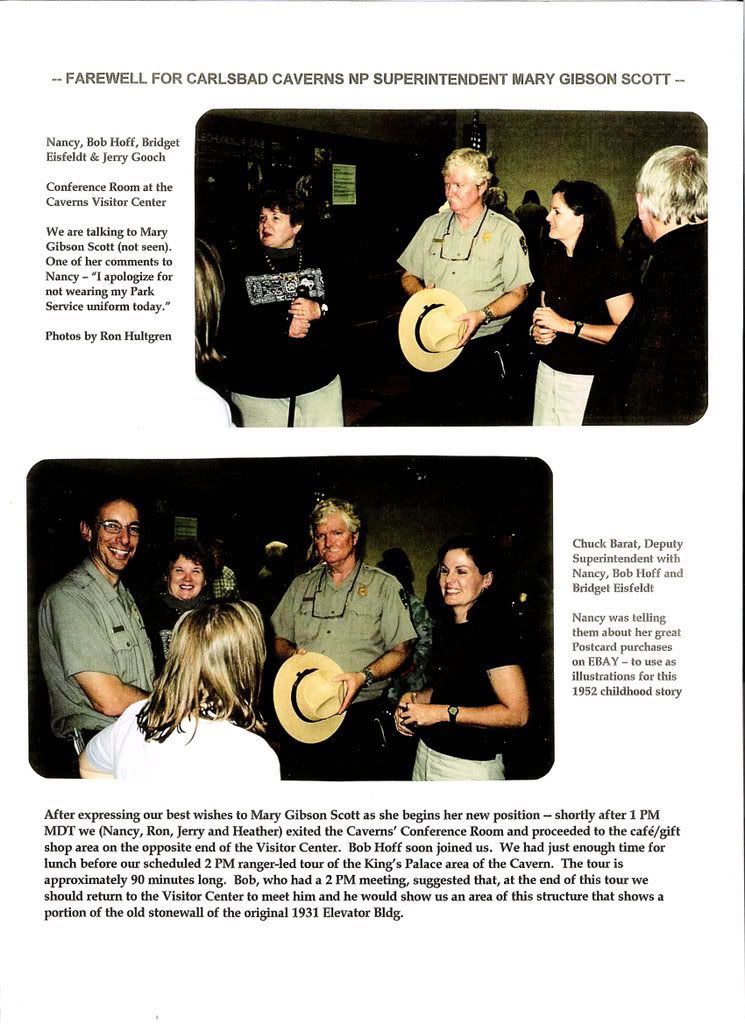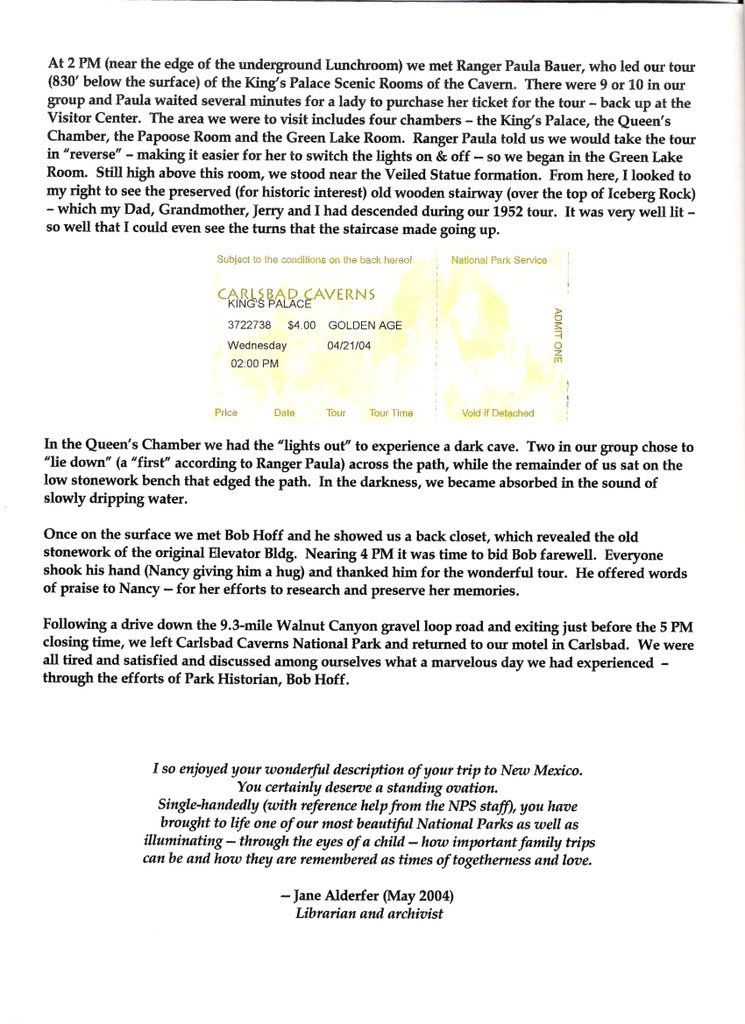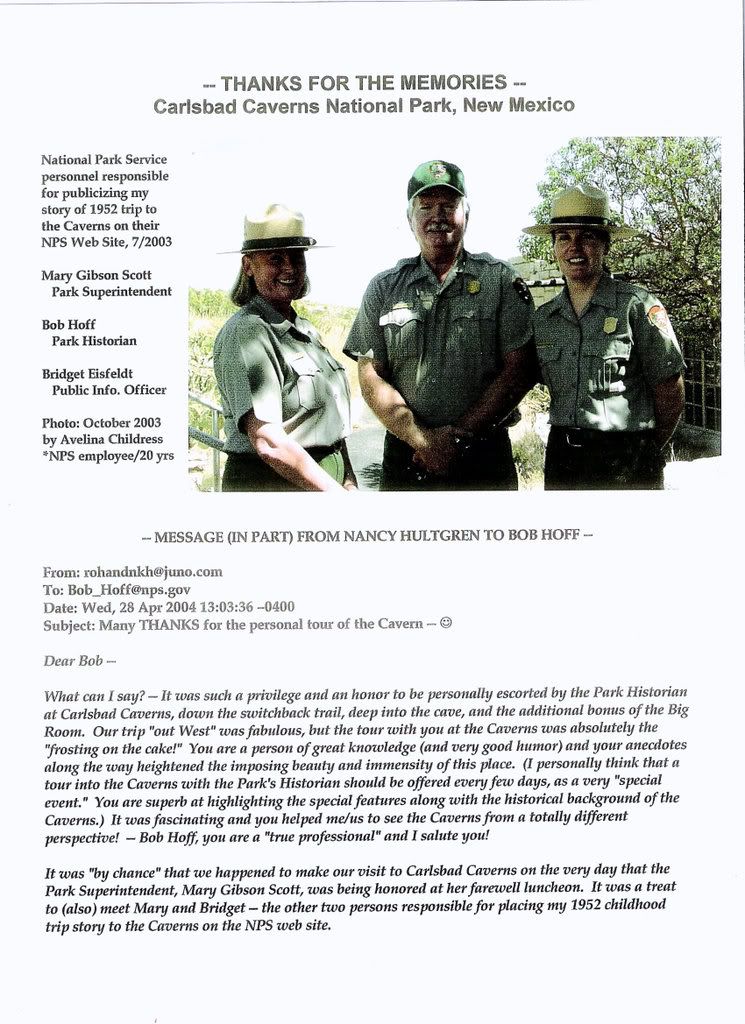Happy National Women's History Month 2009, Everyone!In former caverns Park Ranger's Rebecca R. Lee article about 1924 caverns explorer Elizabeth Lee below, please note what Rebecca said in her last paragraph about the importance of researching and sharing the contributions of women in Carlsbad Caverns history. Rebecca has shown the way as well, in sharing the historical contributions of others to the caverns while making contributions herself.
Thank you, Rebecca, wherever you are.
One
2009 National Women's History Month information at Infoplease.comTwo
Former CAVE seasonal interpreter Rebecca Lee demonstrated a great interest and skill in CAVE history research and writing, added to her general interpretive skills. On a number of occasions--in conversations with me--the "Big Shot Park Historian" :=) --she gently and courteously coaxed me to see historical connections that "she had made" and that "I was missing" at the time about particular historical evidence or concepts or theories. She gave freely of her historical knowledge and intelligence.She had a particular interest in researching and writing about the "Women of Carlsbad Carlsbad Caverns," about which she wrote several chapters in what could have been a book draft, including the chapter below about Elizabeth Lee, easily one of my CAVE FAVES historical women.
Someone else who liked Elizabeth Lee was Jim White, Jr. He once told me that when he was about 5 years old that he had a crush on Elizabeth.
Rebecca R. Lee published an article on The Women of Carlsbad Carlsbad Caverns in The New Mexico Magazine. My copy is not at my fingertips, but "findable" in my "study" I hope. Copies of the article should be in the Park's Library
I find it more-than-perfectly-fitting that in this current month of "Women's History Celebration 2009," that I can shed some light on an important caverns historical figure--Elizabeth Lee--by including in this blog part of a wonderful historical work by arecent caverns' interpreter (2000 or 2001 was her first season--this is a guestimate ) with excellent interpretive and historian research and writing skills-Rebecca R. Lee, no relation to Elizabeth Lee that I know of.
Last I heard from Rebecca, over four years ago, she was living around Ruidoso. If you have e-mail contact information for her, please let me know. I would love to thank her for her past--and present--caverns history contributions.
Picture added Sunday, 3/15/09. I found picture in my files but the picture was printed
on low quality paper and distortion resulted. The colors featured a green tint that suggested that just before the picture was taken, everyone had eaten seafood and a slight group nausea was ensuing. AVELINA: if you have this picture on your computer or in your files, I would like a copy. I am guessing picture date as 1999 or 2000, and don't remember who the photographer was (Ansel Adams?).
Rebecca Lee is in the front row, second from right.

These two pictures below were added 3/13/09-BH)

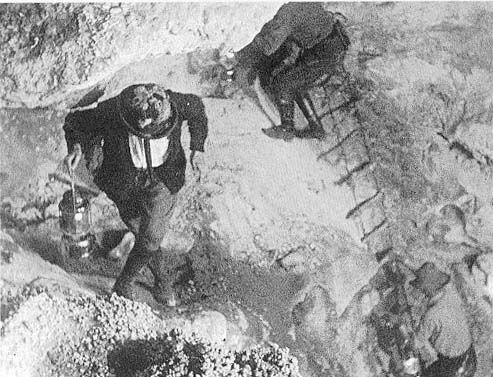
The Professor's Daughter
by
Rebecca R. Lee
On May 30 of 1924 deep within the nether regions of the Chihuahuan Desert miles from the nearest town, a young woman carefully approached a ladder made from strands of twisted wire and tree branches for rungs. It stretched 90' into a distant pit. She struck a match to ignite her light. Nervously, she clutched the warm, wire handle of her gasoline lantern. The flame flickered threatening to go out. Her tread-less boots rested against the top rung on a ladder which cracked and creaked as more of her weight was applied. Mentally she wondered, "Is there enough fuel in the lantern, is the ladder secure, can I really do this?" With onlookers standing idly by, she stared at a familiar face for comfort before her descent. She choked down her fears and stepped bravely reaching for the next rung. One foot after another, she climbed toward the cave's lower floor.
Seventy feet from the bottom of the pit, the wire ladder suddenly began to swing wildly then twist dizzily. Her hands clung tighter to the ladder before they cramped causing her to release her grip for a moment. She sighed and thought about how happy she will be to get to the bottom but remembered she still had to climb back out of the pit. The floor crept closer with every step. Her lantern hissed as a drop of water hit the globe. It was water from her brow and water from the stalactite above her.
She stopped climbing and peered into the distant darkness below her. What a long fall that would be. As she continued her climb, the motion caused the ladder to buck furiously and she was sure she would never make it. The violent commotion of the lantern hitting the wires of the ladder worried those above but they could not see if she was in trouble. They called out to her and she did not respond. They tried again before there was a sudden hush. It was quiet and everyone wondered if she was all right. They did not hear the thump of a body hitting the floor but the drop is so long that they might not. Once more they screamed at her, she heard them and composed herself before assuring them of her safety. She sighed one last time and continued her trip. Finally, she reached the floor. She was safe and she had made it.
After kissing the floor, she sat her lantern atop a fallen stalactite. It teetered and teased a fall. Shadows encircled her like an army of protectors from man and light. Voices echoed in the distance. She gazed up at the people above her. Their tiny images reminded her of how far down she was but she relished her triumph. Then, she realized she was the first woman to enter Lower Cave by climbing into a pit on a wire and wood ladder. This young woman was Elizabeth Lee.
"Liz and I went off the Drop Off and saw the lower level. She thereby advances from a mere member of the mantle Busters Lodge of the Royal Order of Troglodytes to lower level lodge. She is first white (or and other color) woman to penetrate the depths of the lower level."
excerpt from Dana Lee's diary, 1924.
Elizabeth did become the first woman to enter Lower Cave by climbing down a ladder hanging from a drop off. But, which drop off was it? A common consensus was that Elizabeth entered Lower Cave for the first time from the Jumping Off Place in the Big Room. However, many accounts of Jim White's first descent into Lower Cave suggest that Jim was lowered by a rope for his first time through what is now known as the National Geographic Pit. Tales of his descent indicate that Jim and another man looked over the edge of the Jumping Off Place, decided the climb back out would be treacherous, noticed another hole nearby that funneled to an unknown length, and chose that route. Jim then was lowered on a rope through the pit, screamed "whoa" which was mistaken for "go", and subsequently was sent plunging into a pool of water. (1) The Jumping Off Place has no pool of water beneath it. The National Geographic Pit does.
Assuming Jim White did enter Lower Cave for the first time through the National Geographic Pit, why would further descents into Lower Cave go from the Jumping Off Place? The Jumping Off Place is a scary area where the floor of the Big Room suddenly breaks away and falls to a depth of 90'. The National Geographic Pit is a hole in the floor with a flowstone wall sloping toward the cave's lower floor. Who would be so crazy as to climb down a wire ladder from the Jumping Off Place?
What about the accounts in Dana Lee's expedition diary of Jim making a ladder for the "jump off at the end of the Big Room" and Dana's own words of the explorers going off the "drop off"? (2) This clearly implies the Jumping Off Place but maybe not. Historically, names of formations, trails, and pits have been lost and even migrated to others. It is not inconceivable that the National Geographic Pit was called the drop off or jump off. The expedition party certainly would not call the pit the name it is known as today. It is called the National Geographic Pit now because it was the pit documented the most as being the one the National Geographic expedition members used. There is no reason to think anybody in the cave's history ever went down into Lower Cave from the Jumping Off Place. Or is there?
Willis T. and Dana Lee write about the ominous climb down into Lower Cave by wire ladder. Both say that the ladder hung free for seventy feet. (3) Where the ladder is now in the National Geographic Pit would not render a free hanging climb but rather one against a sloping wall. Unless, the ladder was in a different position before it is now. And, it very well could have been.
According to Carlsbad Cavern: The Early Years, "The government men finally shifted the ladder to a point reachable only by inching along one whole slippery side of the pit." Only the National Geographic Pit has a slippery side that must be inched along. So, where does the term "free hang" come from? Perhaps it comes from the fact that the ladder while attached at the top hung free from being attached at the bottom. Or, the first methods of climbing down were from the ladder being anchored at a different place. One such place exists. From the existing trail in the Big Room directly under the man made wall, a ledge is undercut opening the pit to a free fall. Was this the first place the ladder was hung? Whichever pit Elizabeth made her first descent into Lower Cave is debatable. The fact that she did it is not. A photograph of her stepping carefully across the rim of the National Geographic Pit clearly places her there. (4) Carlsbad Cavern: The Early Years mentions that, "Once Elizabeth slipped and teetered on the rim of the pit for endless milliseconds." If she did, her slip was undaunting. The debate over which pit was the culprit will remain because without more information history will never know. One thing history can be sure of is that Elizabeth Lee entered Lower Cave and considering the method that is amazing.
In the course of a person's life there occurs a series of events
that eventually leads that person to her destiny.
In 1923, Willis T. Lee, a geologist, was encouraged by Richard Burges, a lawyer from El Paso, Texas to see a great cavern about which people had been talking. The cavern was only 20 miles away from the irrigation dam site north of the town of Carlsbad, New Mexico which Lee was checking to determine its suitability for a reservoir. While scouting locations for reservoir sites, Lee found limestone, gypsum, and small caves in abundance and realized these sites would never effectively hold water. Knowing the Southeastern New Mexico area was plagued with caves, he never encouraged a site to be used. Though the McMillan Reservoir in the Pecos River Valley was reconstructed after Lee's findings with leaky consequences. (5)
In visiting the cavern, Lee's eyes widened, his heart opened, and he knew he was in a place like no other and far more spectacular than the small caves he had seen in the area. A mission had suddenly come before Willis T. Lee. He wrote many reports and met with powerful groups in a push for the cavern to become a national monument. Partly from his efforts, Carlsbad Cave National Monument was created that same year. (6)
While the National Park Service was considering to grant national park status to the cavern which it eventually did in 1930, the National Geographic Society became interested in the cave. The Society set aside $16,000 for an expedition to take place in order to explore and map the cave as well as make the cave accessible. The Society appointed Willis T. Lee in charge of the expedition.
Lee took leave from the U. S. Geological Survey for one year and took a position as temporary custodian of Carlsbad Cave National Monument. (7) Lee rented the comfortable home of Carl Livingston, a local lawyer and soon to be expedition member, and moved his family to Carlsbad in the spring of 1924. (8) With that move, Willis T. Lee helped his daughter Elizabeth become the cave's first, notable female explorer.
A Family Affair
Willis T. Lee was very proud of his family and their involvement in the expedition was inevitable. Carl Livingston once wrote, "Dr. Lee was a great old gentleman, but he had his vanities, and one of them was his children." (9) His son Dana proved to be a valuable cave explorer and expedition member possibly seeing more of the cave than anyone in the family. Lee's wife Mary Ingham showed little interest in the cavern and stepped inside only once. (10) Dana remarked about his mother's visit to the cave, "Although we boosted her in a few places and had to stop and let her rest frequently, she came through fine." (11) However, her participation in the expedition would be limited to the surface. But Lee's daughter Elizabeth took to cave exploration like her younger brother and became the premiere female caver of Carlsbad Caverns National Park. To tell the story of Elizabeth Lee is to leave much of the story untold but what is known of her story is well worth telling.
Elizabeth Louise Lee or Bettie was born in Trinidad, Colorado around 1902. (12) Other than being adopted into the Hopi Indian tribe as a young girl, little is known of her childhood. (13) In her college years at Syracuse University where Elizabeth graduated in 1923 with a Bachelor of painting, Elizabeth and other students found time from studies to "crawl into a cave near Green Lake on the Jamesville Road." (14) Later, Elizabeth remembered that the very cave they curiously explored "fell in afterward." (15)
What can be determined is that Elizabeth had a fine artistic sense coupled with an adventurous flair doing anything from using watercolors to paint cactus blossoms to riding the desert range on a cavalry horse. (16) During the expedition when two Army aviators flew in to see the cavern, they brought with them a new adventure for Elizabeth. She took a 20 minute roundabout flight with the airmen and Elizabeth's excitement for flying would became about as turbulent as her stomach. (17) She was a strong, fearless, and attractive lady with a genteel and sophisticated air. There seemed to be nothing Elizabeth would not do and it was that reliability which made her valuable to her father and his expedition.
Getting There
Elizabeth arrived at the cavern on March 20, 1924 with the rest of the exploration party. A few days later after traveling to El Paso for an unknown reason, she returned to the cavern with Russel R. Runyan who was from the Topographic Branch of the U. S. Geological Survey and was to map the cave. (18) Richard Burges drove the two up the treacherous, unpaved road in a "big Hudson." (19) The car had such a hard time climbing the unforgiving road made for wagons hauling guano from the cave that the bouncing and pushing made Runyan extremely sore and unable to work in the cave for a few days. (20) Further attempts to maneuver the vehicle up the road would not be dared and later the incapable Hudson was left at the base of the mountain to wait among the other unworthy vehicles. (21) This was not all together a bad idea as the road was so primitive it consisted of notches in the rock and piles of small boulders on the low side of the mountain to keep cars from leaping haphazardly off the road. (22) A precipitous, almost impassable road, the rocks were jagged and sidling was constant. The Lee's managed to get to the cave consistently in a Model T Ford with a "Rucksteel axle." (23) Most Model T's had gravity fed fuel pumps requiring them to back up the hill to the cave but a car made by the Willys Company, the predecessor of the Jeep, called a Baby Overland could negotiate the hill with the passengers facing forward. (24) A better, easily traveled road was necessary if the cavern was to be visited as not everyone owned a Baby Overland and an objective of the expedition was for improvements to be made to the road. (25)
Secretary For A Day
As part of the expedition, Elizabeth was paid $100 a month to work in the cavern. (26) She was originally assigned as a secretary to the expedition but later her father changed her assignment when as he put it, "She proved that she could be useful as a cave woman. She assisted me in the cavern much of the time especially in the photographic work." (27)
As a general handy woman, her duties ranged from the creative to the physical. Donned in calf length boots, baggy trousers, a button-up, long sleeved shirt (usually white), neck tie, and a floppy hat, Elizabeth strayed from the traditional clothing women were wearing in caves at the time and looked the part of a real cave explorer. She was truly dressed to get dirty.
Being a guide at the cave was an obvious duty for Elizabeth as her father was aging perhaps too fragile to make repeated trips into the cave. Thus, she became the cave's first female guide.
Her brother Dana also worked in the cave but his duties were typically limited to manual labor. Elizabeth and Dana were said to be able to do what Jim White had done except operate the guano bucket brake. (28)
It is worth mentioning that Elizabeth must have made an impression on Jim White. In his book, "Jim White's Own Story," he remembers Elizabeth, her mother, her father, and an aid being dispatched to the cave for the expedition. (29) Whether he simply forgot Dana's name or his elaborate ghostwriter was uncertain of who the aid was is not for sure but what is for sure is that Willis T. Lee's only son is not mentioned in the book.
Some days visitation to the cave was so heavy that everyone led tours into the cave. On one particular day, Jim White took a group of visitors on a tour and while he was away, another group arrived anxious to see the cave. (30) It was group of students on a field trip for a geology course. Historically, it would be Elizabeth who took the first group of geology student on a tour through the cave. (31) Possessing a rare knowledge of speleology and geology learned from her father, Elizabeth was an educated and able cavern guide.
You Ought To Be in Pictures
With photography as one of his many talents, Willis T. Lee quickly learned the art of cave photography but it was his reliance on Elizabeth's keen artistic eye that helped him improve his photos that are so revered today. Although Elizabeth suggested the shading of the light and the composition of the print, it was the National Geographic Society who urged Willis T. Lee to include people in his photos. (32) As a photographic advisor, Elizabeth not only held magnesium flares for light and coached in the creative arrangement of photos, but posed in the pictures and films for scale and life action. (33)
Photographic trips were made to the Devil's Spring, the Music Room, the Devil's Den, the King's Palace, the Big Room, and Lower Cave suggesting that in the span of six months the Lee's moved quickly around the cave's miserable, undeveloped trails seeing and surveying as much cave as they could. It has been estimated that the Lee Survey documented 4.6 miles of cave passage. (34) With Elizabeth as her father's photographic assistant, it can be concluded that Elizabeth saw and scrambled through at least that much cave.
"When we were photographing objects of beauty or interest
in the caves to go with our story of the new discovery,
Dr. Lee would say, `Daughter Elizabeth, you stand right
over there. That's it. Now face the camera.
Son Dana, you stand right over there.
That's it. Now face the camera.
Come a little closer both of you. That's fine."
excerpt from Carl Livingston's article, "Other Men's Bones."
On March 28, 1924, a photographic crew from International News Reel came to the cave to take "moving pictures," as Dana put it. (35) It was to be the first movie made in the cave. Trail workers temporarily became part of the film crew as Elizabeth had not been there long enough to take on the duty. (36) Of course the alluring Elizabeth would still be included in the film making process. As the only female member of the expedition, she would certainly add a touch of class that could be lost among men and rocks. However, she was mistakenly titled in the credits of the film as Dr. White's daughter. (37)
As word and pictures of the cave began to circulate, they would soon find themselves in the lap of Hollywood. According to Carl Livingston, Hollywood came to the cave on May 14, 1924. The Fox Film Company with Henry Otto as director arrived at the cavern in hopes of filming part of their movie, "Dante's Inferno." Mr. Otto was looking for just the right place to film the scenes of hell. The idea was that a great cavern would be the perfect place. After all, caves descend deep into the wicked underworld and bring about feelings of doom and despair.
When Livingston explained to Willis T. Lee what the Fox Film Company wanted to do, Lee exploded, "Smoke up my caves! Livingston I'll have you understand that no movie outfit is going to smoke up my caves!" Otto and Livingston quickly realized what had to be done in order to film footage and offered to make the film an educational one which Dr. Lee could use in his lectures. That was exactly what Lee needed to hear but he made one undeniable request. The film had to feature him and his daughter Elizabeth. It was agreed. Lee instantly forgot that the cave would still be "smoked up" just as it was when the International News Reel filmed its footage but it probably was not the smoke Lee was concerned about rather it was his pride. (38)
Dana Lee's diary tells a different story for why "Dante's Inferno" was never filmed at the cavern. Dana remembered, "They (the Fox Film Company) decided that it would be too expensive at present, but wanted to take some movies of the cave anyway." (39)
In Carl Livingston's writings, it is quite apparent that he harbored some animosity toward Willis T. Lee and so his version of the story may have been tainted. Whatever the true story, allegedly the film was a successful venture though the cave did not look much like hell. The movie star Elizabeth is said to be leaping gracefully over a crevice in the cave in addition to Dr. Lee pointing out a stalagmite to Elizabeth's amazement which she most likely had seen many times before? Was she an actress as well?
Batty
Willis T. Lee wrote, "It was quite obvious that all who worked regularly in the cavern were under mental strain." (40) The unwarranted fear that the roof of the cave would fall in seemed to be on the minds of everyone who entered. (41) Time in the Carlsbad area was not only spent working in the cave. Relieving that mental stress led workers and the Lee's to other activities. Concerts and movies were obvious outlets as well as church going, swimming at Sitting Bull Falls, and hunting. (42)
Elizabeth knew her way around the barrels of a shotgun. While other workers were shooting birds and cottontail rabbits for food, Elizabeth and a man named Vernon Bailey were shooting bats. (43) Vernon Bailey was from the U. S. Biological Survey and came to the cavern to study bats. (44) It would be very easy to chastise Mr. Bailey and the Lee's for shooting bats; however, in the ignorance of another era, it can be understandable. In those days, some folks believed dark places harbored witches and demons. Since bats live in dark caves, it was thought that they must be servants of evil spirits. (45) Most people simply believed the age old myths that all bats swarm toward people's hair, were deadly carriers of rabies, and sucked the blood from people like vampires. Of course, Vernon Bailey was well aware of these myths being the scientist he was and was seriously capturing or killing bats for a more logical reason. Reasoning which probably educated the Lee's on the benefits and wonders of these tiny mammals. The photographer in Willis T. Lee was moved to immortalize the bats in pictures. Later, he wrote in his manuscript about going to the natural entrance in the evenings to enjoy the fabulous flight of the bats. (46)
Bailey also trapped and stuffed skunks, ring tail cats, and rock squirrels all in the interest of science. (47) But, it was the bats he was most interested in and enlisted the help of Elizabeth in netting and shooting bats as they flew from the entrance of the cave. (48) Shooting the bats seemed to be the easiest method for catching the little creatures but it can not be left unsaid that many times nets were used to capture the bats or the bats were just plucked from a cave ceiling, "like one would pick apples from a tree." (49) This in no way makes it less cruel or disturbing to modern day cavers and scientists, but Vernon Bailey's methods of bat collecting led to the finding of many unknown bat species and a better understanding of bat biology. (50) Elizabeth's marksmanship enabled her to participate in Bailey's bat studies and perhaps grow a little wiser in the importance of bats in this world.
Today we went out to McKittrick cave, 18 miles west of
Carlsbad. Jim White showed us where to go, and then
Mr. Bailey, Elizabeth, and myself went in.
One of the three (bats) was only asleep for the day
so he was quite lively after we got him.
He bit Elizabeth's hand and made her squeal."
excerpt from Dana Lee's diary, April 13, 1924.
Canyons And Caves
While work in the big cave progressed, the Lee party developed an urge to explore and photograph other caves and canyons in the Guadalupe Mountain range. Currently, 300 caves are known to exist in the mountain range which is more than was known in 1924. (51) Yet, there were still enough caves in the region to keep the Lee party interested. Entering only a few caves prior to living in Carlsbad, Elizabeth found herself exploring cave chambers like she had been a "dirty ol' caver" for years.
"Caves have always fascinated me," she said.
excerpt from "Syracuse New York Daily Orange" article.
McKittrick Cave, on Bureau of Land Management land, is one of the first caves the Lee's explored. (52) The group collected bats in the cave but also rambled through the low passages bumping heads (before cavers wore helmets) and cramping backs. (53) Historic signatures abound in this cave but the Lee's were reluctant to add to the graffiti and so there is no record of a Lee signature. (54) They crept into another cave nearby but found no bats or anything else to interest their imaginations. (55)
Later, the expedition party visited Sitting Bull Falls and Last Chance Canyon in the Lincoln National Forest. (56) The cascading falls glistening in the sunlight on a hot summer day made for a remarkable photo opportunity. Many pictures were taken with of course Elizabeth centered in some of them. After the day's work, the Lee's jumped into the bone chilling pools to cool the sweat on their brows. (57)
A cave located just under the falls tempted the Lee's to enter. Dana wrote, "The cave is very small but just as pretty as anything in the big cavern." (58) A sentiment which continues about Sitting Bull Falls Cave to this day.
The Lincoln National Forest and its borders cradle many beautiful and fascinating caves and canyons and the Lee's would have been remiss not to try to see some of them. Cottonwood Cave, Hidden Cave, and Giants Cave (Black Cave) were all visited by the party. They remarked about seeing huge formations in Cottonwood Cave that rivaled those in Carlsbad Caverns, squeezing through the narrow crack entrance of Hidden Cave to find picturesque beauty and later sliding down a 20' long rope to the cave's larger regions, and finding the bones of a man and signatures (dating back as far as 1845) of many men in the dark corridors of Giants Cave. (59) Once again, the Lee's resisted the temptation to add their names to the wall of shame. (60)
The expedition party traveled over a foot trail to Deep Cave which lies between the towering Double and Gunsight Canyons. (61) Hearing a rumor from a guano miner that the cave sank more than 500', the Lee's were content to just stand by its edges, kick a few rocks over, and stare into the hollow blackness. (62) If the opportunity to be lowered into this cave of an uncertain depth existed, perhaps the daring and foolhardy adventurer in Elizabeth would have also made her the first women to enter Deep Cave.
A Spirited Explorer
Whether Elizabeth's first trip on May 30 into Lower Cave was quite that distressing or not is unknown but it was the way many climbs down that free hanging 90' ladder occurred. It was a maneuver few men of the expedition would even try. If riding in a guano bucket for a total of 340', climbing a rickety ladder for a total of 346', or hiking along trails made of bagged guano was not enough adventure for Elizabeth to endure daily, then her descent into Lower Cave was inevitable. It was Elizabeth's spirit of exploration that marked her name in history as the first woman in Lower Cave not the result of being Willis T. Lee's daughter. It was her drive to see what the men were seeing that made exploration her favorite duty at the cave.
"He (Willis T. Lee) had brought both of them
(Elizabeth and Dana) along on the trip, and
they were with us on most of our explorations."
excerpt from Carl Livingston's article "Other Men's Bones."
Had Elizabeth's climb into Lower Cave resulted in a serious accident or even her death, she would have been notorious. As it was, being the first woman in Lower Cave was less than a claim to fame. Accidents in cave exploration add interest, intrigue, and excitement to the story. Willis T. Lee wrote, "Artificially prepared `accidents' might have been staged for the purpose of adding zest to the story. But where there is real danger such staged incidents would be inexcusable. No byplay was permissible where real danger was always present as it was in the cavern. Ours was just a successful exploration one carried to completion without
any sensational incidents. A few slight injuries were sustained but no one was lost or even seriously injured." (63) Thus, careful cave exploring did little to enhance Elizabeth's notoriety at the cave but saved her life nonetheless
Every caver eventually has some incident usually involving the lack of light that is minor but could have become serious even life threatening had the situation prevailed. Elizabeth's caving career was not without a few such incidents. Mostly from the lack of technology did these problems occur. The source of light in 1924 was primarily a gasoline lantern. (64) Previously, open flame kerosene torches were the main light source but the Lee party chose to use gasoline lanterns as the torches produced too much smoke in the cave and the effect on formations was disturbing. (65) A gasoline lantern was brighter and smokeless making it an acceptable light. (66) However, even the gasoline lanterns caused problems as Elizabeth knew all too well.
The Welsbach mantle in the lantern was fragile making it incompatible with cave exploration. (67) To maneuver carefully through a cave was hard enough without having to maneuver a lantern through the cave just as carefully. The slightest bump of the lantern could plunge a caver into total darkness. (68) Extra mantles were a must but it was virtually unheard of to go through a day of cave exploring without using all of the mantles and frequent trips to Carlsbad were made by Elizabeth and her father to purchase more mantles. (69)As an example of the danger these lanterns could impose upon an explorer, Dr. Lee and Elizabeth found themselves picking their way along the undeveloped trail in the cave one day by the dim light from a shattered mantle. Elizabeth had tripped in the cave and broke the mantle. It managed to glow just bright enough and long enough for the two to get out of the cave. Where were their other light sources? Apparently, both mantles Dr. Lee had were destroyed and they had no extras. Dr. Lee remembered having to use backup lights such as electric flashlights and paraffin candles on many other occasions. That is, if he remembered to bring them. (70)Losing light in a cave like finding unexplored cave passage raises a caver's adrenaline level. Minor incidence aside, excitement came from exploring the cave too. There can be nothing more exhilarating for a caver than being the first eyes to see a beautiful cave chamber or finding something so significant as another entrance into the cave. While exploring Lower Cave, the expedition hoped to find a third natural entrance into the cave. (71) It was thought that at the lower level an easier entrance into the cave could exist. It proved unfounded. Their eyes not only looked down, they also looked up at the ceilings of the cave.
"
Their (cave ceilings) mysteries remain unfathomed.
They beckon to some explorer of venturesome spirit,
inviting him to test his prowess and daring."
excerpt from Willis T. Lee's unpublished manuscript, 1924.
There were many ideas of how to reach the higher passages but one idea of particular interest could have actually worked. Cowboys in the area offered to "rope" stalagmites allowing for that rope to be climbed to otherwise unreachable passages. (72) Could this be how Elizabeth found her way into a hole near the Giant Dome in the Big Room? It is unlikely as Willis T. Lee recounts in his manuscript that the lariat method was never attempted. (73) Rumor has it that the initials "E. L." are etched upon a wall in a hole above the Lion's Tail. A climb in 1989 to explore the hole was done by cavers with some difficulty. After reaching and exploring the hole, it was noted that those initials were found and thought to be those of Elizabeth Lee as no other explorer of the cave with those initials was known to exist. (74) Unfortunately, notation of the climb has been lost within the transition stages of the Cave Resources Office at Carlsbad Caverns National Park. (75) If the rumor is true, how did she and others get to that hole? If the rumor is true, it would be the only Lee signature known to exist in any cave. This is important as Dr. Lee was a pioneer of cave preservation and looked down on visitors for defiling the cave with signatures and vandalism. (76) Could his own daughter leave graffiti in his cave? If she did, it could be understandable as the climb might have been such an ordeal that she wanted future explorers but not her father to know she was there. A reclimb to the hole near the Giant Dome was done on March 2, 1999 and no signature was found. However, the climber did not completely enter the hole as it was too dangerous. The mystery remains.
The Expedition Party's Over
The bulk of Willis T. Lee's work and findings are published in his 1924 and 1925 National Geographic Magazine articles. Even Dana Lee wrote a diary recording his six months at Carlsbad Caverns. But, the time Elizabeth spent at the cavern is documented in only a few places and not by her own hand. Only one small article is known to exist with a few of her own words. A diary, more articles, or anything else in her own words would give a voice to Elizabeth Lee. As it is now, Elizabeth is silent, frozen in time, frozen in pictures. So minute and scattered is the documentation of her work at the cavern that a reader or researcher could easily skip a page or two and never know she existed. To call Elizabeth Lee the female equivalent to Jim White is to compare Elizabeth's work at the cave with Jim White's. A close comparison by no means but a relative one considering the few opportunities women were given to work in the cave at the time. Elizabeth was at the cavern no longer than a few months but was able to do and see more in that span of time than most people.Whatever became of Elizabeth after the National Geographic expedition? In September of 1924, the expedition party packed its bags and headed in different directions. After touring Northern New Mexico with the family, Dana departed for Washington D. C. to pursue a job with the Bureau of Standards. (77) Elizabeth and Dr. Lee continued on to what is now El Malpais National Monument to see "the big volcano." (78) There, photos and studies were made of Candelaria Ice Cave. (79) Without doubt, Elizabeth is photographed in many of the pictures wearing her typical caving attire. (80) Text in Natural History Of El Malpais National Monument by Ken Mabery claims the Lee photos to be the earliest of the Ice Cave and reads, "The Lee images are undated, but the lady in the three photographs appears in a 1925 Lee photograph of Mammoth Caves, Kentucky; she appears to be wearing the same hat." (81)Carlsbad Caverns obviously held a special place in Elizabeth's heart. Records in the cavern archives show that Elizabeth returned to the cavern to visit as a married lady on July 5, 1936 and on August 7, 1954. (82) An atypical life at the cavern gave way to a typical life elsewhere. When Elizabeth left the cavern, she went on to continue her art in a commercial art studio in Syracuse, New York being seen daily drawing meticulously with a brush and pencil "adding her bit to the art and advertising of the growing city." (83) Elizabeth's niece Mary Lee Hu says Elizabeth later moved to West Lake, Ohio, married a man named John G. Hopkins who died in 1974, adopted a daughter called Mary Lu Toth, retired with her husband in Green Valley, Arizona, and traveled to Taos, New Mexico in the summers to paint landscapes. (84) Elizabeth's nephew Richard D. Lee remembers Elizabeth passing away from abdominal cancer in a hospital in Green Valley on July 12, 1978. (85)Her unsung brother Dana Lee who kept the best records of Elizabeth's work in the cavern passed away later on July 5, 1992 in Seattle, Washington also from cancer. (86) Both were preceded in death by Willis T. Lee who died prematurely in Washington, D. C. on June 16,1926 as a result of paratyphoid fever. (87) Jim White who died in Carlsbad on April 28, 1946 of a sudden but not totally unexpected stroke. (88)A strong explorer and significant to the history of Carlsbad Caverns National Park, Elizabeth Lee can indeed be called the female equivalent to Jim White. The first woman to seriously explore the cave, the first woman to enter Lower Cave, and the first woman to be a guide at the cave, Elizabeth's notoriety has unfortunately been lost within the pages of history. But, history can be changed. The more that is learned about the women of Carlsbad Caverns the more they will be included in the making of the park and in the history of the park as more than wives, daughters, mothers and sisters. Elizabeth Lee probably knew that she was making history every time she entered Carlsbad Cave but was more interested in the cave itself. With the help of her father's ordinary plate camera, Elizabeth Lee and Carlsbad Caverns will forever be timeless and beautiful.
"You can't say enough for Carlsbad Caverns,"
Miss Lee asserted.
excerpt from "Syracuse New York Daily Orange" article.
Bibliography
For Elizabeth Lee chapter
in paper by Rebecca R. Lee
(1) Meador, Tom. "Carlsbad Cavern And Jim White: A History." Carlsbad Caverns Archives, 1984.
(2) Lee, Dana W. "The National Geographic Society's Expedition
To Carlsbad Cavern, New Mexico, March 20 To September 15,
1924." Carlsbad Caverns Archives, 1924, April 9 and May 5.
(3) Ibid. May 5, 1924.
(4) Nymeyer, Robert and William R. Halliday, M. D. Carlsbad
Cavern: The Early Years. Carlsbad, New Mexico, Carlsbad
Caverns- Guadalupe Mountains Association, 1991, pg. 105.
(5) Ibid. pg. 93.
(6) Ibid.
(7) Ibid.
(8) a. Lee, Dana W. "The National Geographic Society's Expedition To Carlsbad Cavern, New Mexico, March 20 to September 15, 1924." Carlsbad Caverns Archives, 1924, March 24, 1924.
b. Alden, William. "Memorial To Willis Thomas Lee." Bulletin of the Geological Society of America, March 30, 1927,
pg. 74.
(9) Livingston, Carl. "Other Men's Bones." New Mexico Magazine
January, 1934.
(10) Nymeyer, Robert and William R. Halliday, M. D. Carlsbad
Cavern: The Early Years. pg. 94.
(11) Lee, Dana W. "The National Geographic Society's Expedition To Carlsbad Cavern, New Mexico." June 1, 1924.
(12) Alden, William. "Memorial To Willis Thomas Lee." pg. 73.
(13) Syracuse New York Daily Orange. "Former Syracuse Student Is
Experienced Explorer." November 11, 1929.
(14) Ibid.
(15) Ibid.
(16) Lee, Dana W. "The National Geographic Society's Expedition To Carlsbad Cavern, New Mexico." April 30 and April 26, 1924.
(17) Lee, Dana W. "The National Geographic Society's Expedition To
Carlsbad Cavern, New Mexico." September 1, 1924.
(18) a. Lee, Dana W. "The National Geographic Society's Expedition
To Carlsbad Cavern, New Mexico." March 29, 1924.
b. Nymeyer, Robert and William R. Halliday, M.D. Carlsbad
Cavern: The Early Years. pg. 96.
(19) Ibid.
(20) Ibid.
(21) Ibid.
(22) Ibid. March 24, 1924.
(23) Ibid.
(24) Hoff, Bob, "History Leads And Resources." Carlsbad Caverns Archives, September 2, 1994, 94-10.
(25) Hoff, Bob. "The Expedition That Put The Caverns On The Map."
Carlsbad Current Argus. March 3, 1996.
(26) Nymeyer, Robert and William R. Halliday, M. D. Carlsbad
Cavern: The Early Years. pg. 94.
(27) Lee, Willis T. "Unpublished Manuscript." Carlsbad Caverns Archives, 1926, pg. 23.
(28) Nymeyer, Robert and William R. Halliday, M. D. Carlsbad Cavern: The Early Years. pg. 94.
(29) Nicholson, Frank Ernest. Jim White's Own Story. Jim White and Charley Lee White, 1932, pg. 28.
(30) Lee, Dana W. "The National Geographic Society's Expedition To Carlsbad Cavern, New Mexico." June 27, 1924.
(31) Ibid.
(32) Nymeyer, Robert and William R. Halliday, M. D. Carlsbad
Cavern: The Early Years. pg. 97.
(33) Ibid. pg 94.
(34) Hoff, Bob. "History Leads And Resources." Carlsbad Caverns
Archives, 1993, pg 56.
(35) Lee, Dana W. "The National Geographic Society's Expedition To Carlsbad Cavern, New Mexico." March 29, 1924.
(36) Ibid.
(37) Ibid. May 10, 1924.
(38) Livingston, Carl. "The Balloon Blunder." New Mexico Magazine.
April, 1934, pg. 12-14.
(39) Lee, Dana W. "The National Geographic Society's Expedition To Carlsbad Cavern, New Mexico." May 24, 1924.
(40) Lee, Willis T. "Unpublished Manuscript." pg. 36.
(41) Ibid.
(42) Lee, Dana W. "The National Geographic Society's Expedition To
Carlsbad Cavern, New Mexico." April 20, 1924.
(43) Ibid. April 9, 1924.
(44) Lee, Willis T. "Unpublished Manuscript." pg. 12-13.
(45) Hopf, Alice L. Bats. Dodd, Mead, and Company, New York, 1985, pg. 8.
(46) Lee, Willis T. "Unpublished Manuscript." pg. 13.
(47) Lee, Dana W. "The National Geographic Society's Expedition To Carlsbad Cavern, New Mexico." March 29, 1924.
(48) Ibid. April 14, 1924.
(49) Ibid. April 13, 1924.
(50) Ibid.
(51) Jagnow, David H. and Rebecca Rohwer Jagnow, Stories From Stones- The Geology Of The Guadalupe Mountains. Carlsbad
Caverns- Guadalupe Mountains Association, Carlsbad, New Mexico, 1992, pg 33.
(52) Lee, Dana W. "The National Geographic Society's Expedition To Carlsbad Cavern, New Mexico." April 13, 1924.
(53) Ibid.
(54) Lee, Rebecca R. "Interview With Jim Goodbar."
September 15, 1998.
(55) Lee, Dana W. "The National Geographic Society's Expedition
To Carlsbad Cavern, New Mexico." April 13, 1924.
(56) Ibid. July 20, 1924.
(57) Ibid. May 20, 1924.
(58) Ibid. July 20, 1924.
(59) Ibid. August 12, 1924.
(60) Serface, Roberta. "Historical Signature Report In Black Cave." 1998.
(61) Lee, Dana W. "The National Geographic Society's Expedition To
Carlsbad Cavern, New Mexico." August 12, 1924.
(62) Ibid.
(63) Lee, Willis T. "Unpublished Manuscript." pg. 31.
(64) Ibid. pg. 29.
(65) Ibid.
(66) Ibid.
(67) Ibid.
(68) Ibid.
(69) Ibid. pg. 30.
(70) Ibid.
(71) Ibid. pg. 139.
(72) Ibid. pg. 138.
(73) Ibid. pg. 139.
(74) Lee, Rebecca R. "Interview With David Ek." August 26, 1998.
(75) Ibid.
(76) Lee, Willis T. "Unpublished Manuscript." pg. 120.
(77) Lee, Dana W. "The National Geographic Society's Expedition To Carlsbad Caverns, New Mexico." September 15, 1924.
(78) Ibid.
(79) Mabery, Ken. Natural History Of El Malpais National Monument.
New Mexico Bureau of Mines And Mineral Resources, Socorro, 1997. Bulletin 156, pg. 94.
(80) Ibid.
(81) Ibid. pg. 99.
(82) a. Boles, Thomas. "Superintendent's Annual Narrative Report." Carlsbad Caverns Archives, August 6, 1936, pg. 5.
b. Hoskins, R. Taylor. "Superintendent's Monthly Narrative Report." September 9, 1954, pg. 3.
(83) Syracuse New York Daily Orange. "Former Syracuse Student Is Experienced Explorer." November 11, 1929.
(84) Lee, Rebecca R. "Interview With Mary Lee Hu."
September 4, 1998.
(85) Lee, Rebecca R. "Interview With Richard D. Lee."
September 9, 1998.
(86) Lee, Rebecca R. "Interview With Mary Lee Hu."
September 4, 1998.
(87) Alden, William. "Memorial To Willis Thomas Lee." pg. 88.
(88) Boles, Thomas, "Superintendent's Monthly Narrative Reports."
Carlsbad CavernsArchives, May 8, 1946, pg. 5.
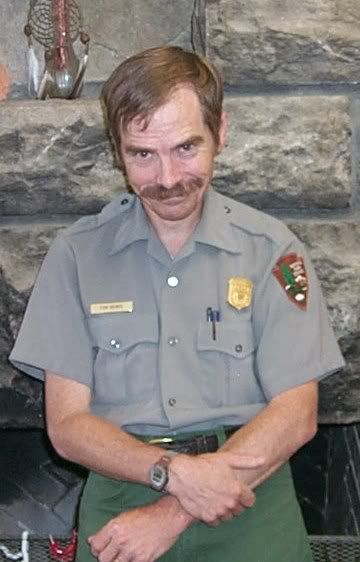 My friend and ex-CAVE co-employee, Tom Bemis pointed out by e-mail (and we later spoke on the phone) that I was misleading you readers with what I said about the Shaft of Light so I asked him to explain it so that I could update the 3/26 post. Of course, he did, and of course, he did a good job. Here is what he sent me earlier today.
My friend and ex-CAVE co-employee, Tom Bemis pointed out by e-mail (and we later spoke on the phone) that I was misleading you readers with what I said about the Shaft of Light so I asked him to explain it so that I could update the 3/26 post. Of course, he did, and of course, he did a good job. Here is what he sent me earlier today.